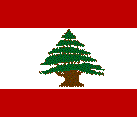Flag

Official name
Republic of Lebanon
Capital
Beirut
Population
3,627,774 (July 2001 est.)
Land area
10,452 sq km
Language
Arabic is the official language, but French and English are widely spoken. Armenian is also spoken by a minority group.
Major religions
50% Muslim; 50% Christian
The largest Christian group are Maronites, followed by the Greek Orthodox, Greek Catholics, Armenian Orthodox, Armenian Catholics, Syrian Catholics, Chaldeans, Protestants and Syrian Orthodox. The largest Muslim group are the Shiite, followed by the Sunni and the Druze.
Early times:
Lebanon's long and often turbulent history reaches back to the dawn of civilization. Its earliest settlers were the Phoenicians who came from the Arabian Peninsula around 3,500 BC. They established cities at Beirut, Byblos, Tyre, Sidon, and Baalbek and spread their 22-letter Phoenician alphabet throughout the region.
After a succession of different rulers, they became part of the Roman Empire in 64 BC when Pomey the Great conquered the territory that comprises modern Lebanon and governed it as part of the province of Syria.
Aramaic replaced Phoenician as the main language and by the 4th century Christianity was firmly established. During the early years of the Christian era, when theological differences bred numerous break-away sects, Lebanon became a refuge for religious minorities fleeing persecution.
In the 7th century, the Christian sect that was later to become the Maronite church settled in the northern districts of the Lebanese Mountains to avoid conversion to Islam. The Arabs, inspired by the teachings of the Holy Prophet Mohammed, had converted most of the region to Islam. The geographical inaccessibility that made Lebanon attractive as a religious refuge also appealed to Muslims; the Shiites found a haven there during the 9th century and the Druzes in the 11th century.
The mosaic of differing beliefs in Lebanon gave each religious group a certain amount of autonomy in specific areas, but hampered unity for the region as a whole.
Modern times :
For a while after the independence of 1943, independent Lebanon was a model ecumenical society. Its strategic Middle Eastern location and relatively stable government made it a major trade and financial centre. But two fatal flaws marred the country's chance for lasting peace.
The first cause for conflict was the unbalanced power-sharing arrangement. Control rested with the right-wing Christian part of the population while the Muslims, who comprised 50% of the population felt excluded from real government.
A second problem arose as Lebanon was gradually drawn in to the Arab-Israeli conflict. Although the country did not actively participate militarily, displaced Palestinian Muslim refugees flooded into the country and continued their attacks on Israel from Lebanese bases.
In 1958 a Muslim rebellion ended when American marines landed in Beirut, but in the summer of 1975 all-out civil war broke out between the Muslim coalition allied with Palestinian groups and the Christian-dominated militias.
In April 1976, an uneasy cease-fire was forced upon the two sides when Syrian military forces intervened at the request of the Lebanese president, Suleiman Franjieh and with the approval of the Arab League of States. Nevertheless sporadic violence continued, and in 1978 Israel invaded southern Lebanon in an attempt to eliminate Palestinian bases.
Withdrawing three months later after a United nations peacekeeping force was sent to the area, they reinvaded in 1982, occupying Beirut and forcing the PLO to evacuate its head quarters. For seven weeks the Israelis relentlessly bombed the Muslim half of Beirut by air, sea and land. The USA arranged for the evacuation of PLO fighters to other Arab Countries, and a multinational Force of US and West European troops was deployed to Beirut to protect Palestinian and Muslim civilians.
After the assassination of president-elect Bashir Gemayel, Israeli-backed Christian militias massacred Palestinian civilians in the Chatila and Sabra camps in West Beirut. A year later Israeli troops withdrew to southern Lebanon. No sooner had they left when fighting broke out between Lebanon's Christian and Druze militias, and terrorist attacks on the multinational force including the US marine headquarters at Beirut airport resulted in hundreds of casualties.
After 300 US and French troops were killed on October 23, 1983, the Western forces pulled out. Factional fighting persisted and Westerners in Beirut became the targets of radical Shiite Muslims with an allegiance to Iran.
In 1988 a parliamentary power struggle led to the formation of rival Christian and Muslim governments. In 1989 the Lebanese parliament accepted an Arab-brokered peace accord for national reconciliation. MPs elected Maronite Rene Mooed as president who was assassinated 17 days later.
With the help of the Syrians, the Lebanese army took control of Beirut and by 1992 under pressure from Iran and the US, all the foreign hostages captured several years earlier were released.
In 1992 Mr Rafik Al Hariri was appointed Prime Minister of Lebanon. Mr Hariri initiated many projects to redevelop war torn Lebanon, especially the capital Beirut, and bring it back to its former glory. Mr Hariri and Lebanese President Elias Hrawi strove to develop the Lebanese economy and moral despite the presence of the Israeli self styled "security zone" in South Lebanon.
On November 24th 1998, army Cmdr. Emile Lahoud was sworn in as the 11th Lebanese President since Lebanon's independence in 1933. On 3rd of December 1998, Mr Salim Hoss became Lebanon's new Prime Minister following Mr Hariri's sudden resignation. Mr Salim Hoss is no stranger to politics, as this is the fifth time he holds the position of Prime Minister.